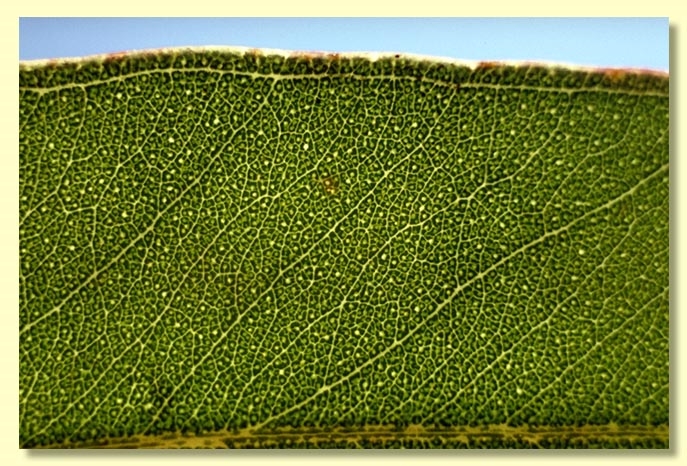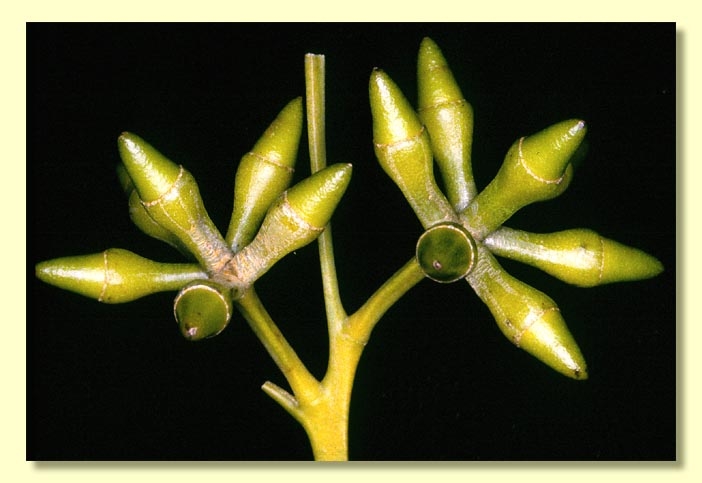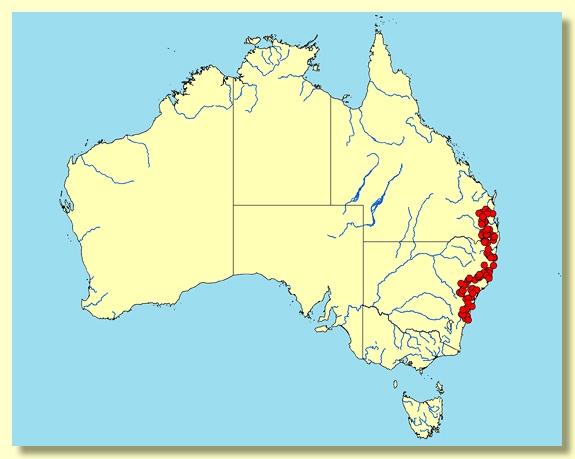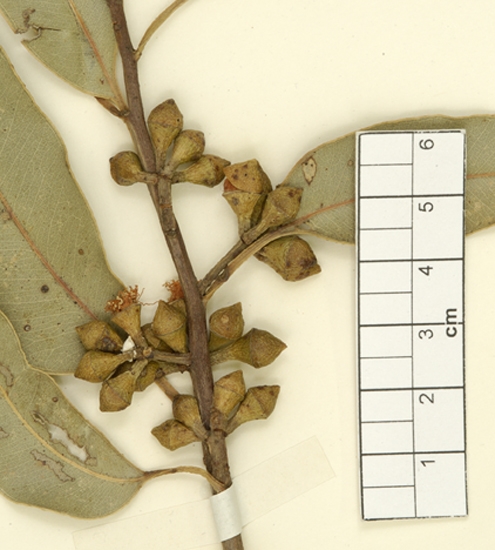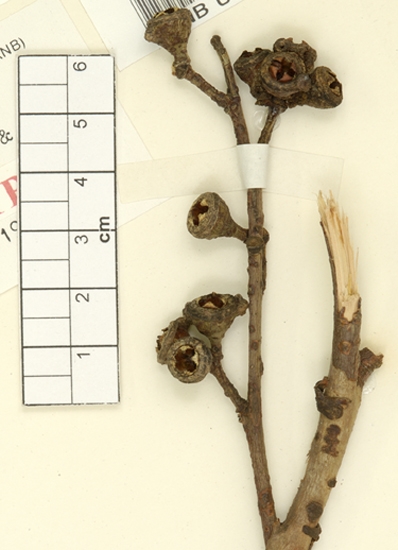Euclid - Online edition
Eucalyptus punctata
Eucalyptus | Symphyomyrtus | Latoangulatae | Lepidotae-Fimbriatae
Eucalyptus tereticornis var. brachycorys Benth., Fl. Austral. 3: 242 (1867). T: New Holland, F.W.Sieber 623; holo: G; iso: G, NSW.
Eucalyptus punctata var. didyma R.T.Baker & H.G.Sm., Research Eucalyptus 127 (1902). T: Rylstone, NSW, June 1897, R.T.Baker; lecto: NSW, fide L.A.S.Johnson & K.D.Hill, Fl. Australia 19: 509 (1988).
Eucalyptus shiressii Maiden & Blakely in J.H.Maiden, Crit. Revis. Eucalyptus 6: 512 (1923). T: 16 mile post, Galston Road, Hornsby, NSW, Feb. 1922, W.F.Blakely & D.W.C.Shiress s.n.; holo: NSW.
Eucalyptus biturbinata L.A.S.Johnson & K.D.Hill, Fl. Australia 19: 507 (1988). T: Kyogle road, 3 miles [c. 5 km] N of Cawongla, NSW, 14 Jan. 1966, R.D.Johnston 149 & A.Nichols; holo: NSW; iso: CANB.
Bark smooth throughout, becoming granular with age, predominantly grey with pink, brown, cream, yellow and orange, shedding in patches.
Juvenile growth (coppice or field seedlings to 50 cm): stem rounded or square in cross-section; juvenile leaves always petiolate, opposite for 3–5 pairs then alternate, ovate to lanceolate, 5.5–11.5 cm long, 1.5–3.5 cm wide, base rounded or tapering to petiole, dull, discolorous, green.
Adult leaves alternate, petiole 1.3–2.6 cm long; blade slightly falcate to lanceolate or ovate, 6–18 cm long, 1.4–3.7 cm wide, base oblique or tapering to petiole, discolorous, glossy, dark green above and paler on the underside, side-veins greater than 45° to midrib, densely to very densely reticulate, intramarginal vein parallel to and just within margin, oil glands island.
Inflorescence axillary unbranched, or sometimes terminal compound, peduncles 1–2 cm long, buds 7 per umbel, pedicels 0.2–0.8 cm long. Mature buds ovoid (0.6–0.9 cm long, 0.4–0.9 cm wide), yellow or creamy, scar present, operculum conical to rounded, stamens irregularly flexed, anthers cuboid or cuneate, versatile, dorsifixed, dehiscing by longitudinal slits (non-confluent), style long, stigma tapered, locules 3 or 4, the placentae usually with 4(6) vertical ovule rows. Flowers white.
Fruit pedicellate (pedicels 0.2–0.8 cm long), hemispherical to cupular, 0.4–0.9 cm long, 0.6–1 cm wide, disc slightly raised, level or slightly descending, valves 3 or 4, exserted or near rim level.
Seeds dark brown to black, 1–2 mm long, cuboid or obliquely pyramidal, dorsal surface pitted, margins toothed, hilum terminal or obliquely positioned.
Cultivated seedlings (measured at ca node 10): cotyledons bilobed to oblong; stems square in cross-section; leaves always petiolate, opposite for 4–5 nodes then alternate, ovate-lanceolate, 5–11.5 cm long, 1.5–3 cm wide, base rounded to tapering, discolorous, darker green above, paler beneath.
Flowering has been recorded in February, May and December.
It has been used in heavy engineering, poles and as railway sleepers.
A small to medium-sized tree belonging to the grey gums, occurring from just south of Nowra on the south coast of New South Wales, north through the ranges and coastal hinterlands to just south of Gympie in south-east Queensland. In New South Wales it can be found growing close to the coast in the Taree – South West Rocks – Coff's Harbour area and extends as far west as the Mudgee area. In far northern New South Wales and south-east Queensland it can be found just east of Tenterfield and crosses the border into the Cunningham's Gap – Helidon – Kingaroy – Jimna area. The bark sheds in about three phases over a year, the newly exposed bark being highly coloured, orange or coppery, and fades to grey which weathers to dark grey, giving a three-coloured mottled effect. The older dark grey bark usually becomes somewhat dull and granular. Leaves are discolorous being paler on the underside, buds and fruits in sevens.
Eucalyptus punctata belongs in Eucalyptus subgenus Symphyomyrtus section Latoangulatae because cotyledons are bilobed, leaves are discolorous and have side-veins at a wide angle to the midrib, buds have two opercula and fruit have exserted valves. Within this section, it is one of six species forming series Lepidotae-Fimbriatae (the Grey gums) with ovules in 4(6) rows and the bark smooth throughout becoming granular with age. The series Lepidotae-Fimbriatae can be informally divided further into two groups based on seed colour and the presence or absence of small teeth on the seed edge. E. punctata, E. canaliculata, E. longirostrata and E. grisea all have black seed that are prominently toothed along the edges. E. propinqua and E. major have brown to light brown seed that have a much smoother surface texture than the other group, lacking the prominent teeth on the seed edge. Also the bark of E. propinqua and E. major tends to shed in strips rather than patches like the other grey gums.
Its closest relatives are E. canaliculata, from the Dungog–Gloucester area of central New South Wales, which has larger, coarser buds and fruit; E. grisea, endemic to central Queensland, which has slightly coarser adult and juvenile leaves; and E. longirostrata, endemic to south-east Queensland, which has a prominently beaked operculum. E. punctata differs from E. propinqua (found in New South Wales and Queensland) and E. major (endemic to Queensland), by the bark which sheds in patches, not strips, and the larger fruit with black, distictly toothed seed.
E. biturbinata, published in volume 19 of the Flora of Australia, has here been placed in synonomy. In the protologue it was compared with E. canaliculata, which clearly has coarser buds and fruit but no comparison was made with E. punctata. Careful observations of herbarium material housed in the Australian National Herbarium in Canberra have shown that E. punctata, across its range, can be variable in the length and shape of the operculum and the shape of the disc. E. biturbinata does not fit outside that variation.



